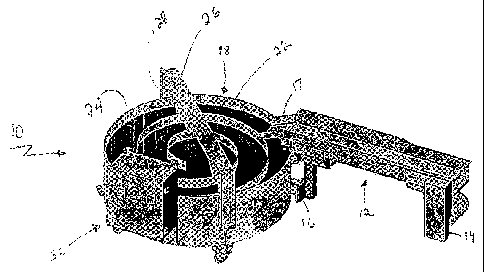Some of the information on this Web page has been provided by external sources. The Government of Canada is not responsible for the accuracy, reliability or currency of the information supplied by external sources. Users wishing to rely upon this information should consult directly with the source of the information. Content provided by external sources is not subject to official languages, privacy and accessibility requirements.
Any discrepancies in the text and image of the Claims and Abstract are due to differing posting times. Text of the Claims and Abstract are posted:
| (12) Patent Application: | (11) CA 2662861 |
|---|---|
| (54) English Title: | ROTARY PRODUCT ACCUMULATOR |
| (54) French Title: | ACCUMULATEUR DE PRODUITS ROTATIF |
| Status: | Deemed Abandoned and Beyond the Period of Reinstatement - Pending Response to Notice of Disregarded Communication |
| (51) International Patent Classification (IPC): |
|
|---|---|
| (72) Inventors : |
|
| (73) Owners : |
|
| (71) Applicants : |
|
| (74) Agent: | SMART & BIGGAR LP |
| (74) Associate agent: | |
| (45) Issued: | |
| (86) PCT Filing Date: | 2007-09-06 |
| (87) Open to Public Inspection: | 2008-03-13 |
| Availability of licence: | N/A |
| Dedicated to the Public: | N/A |
| (25) Language of filing: | English |
| Patent Cooperation Treaty (PCT): | Yes |
|---|---|
| (86) PCT Filing Number: | PCT/US2007/077729 |
| (87) International Publication Number: | US2007077729 |
| (85) National Entry: | 2009-03-05 |
| (30) Application Priority Data: | ||||||
|---|---|---|---|---|---|---|
|
A stand-alone parts accumulator that can be retrofit as a unitary add-on to an existing production line. The parts accumulator includes: (a) a generally linear conveyor; (b) a rotary table comprising a spiral barrier guide defining a path from an outer region of the table to an inner region of the table; (c) a connector attaching the linear conveyor to the rotary table; (d) a motor connected to rotate the rotary table; (e) an adjustable controller connected to the motor to control rotation of the table. A single bracket can be used to support the conveyor in either a left-hand or a right-hand configuration. The conveyor motor is positioned substantially within the footprint of the conveyor. The conveyor is narrow (between about 2 inches and about 8 inches).
La présente invention concerne un accumulateur de pièces autonome qui peut être installé en tant qu'élément supplémentaire unitaire dans une ligne de fabrication existante. L'accumulateur de pièces comprend : (a) a convoyeur généralement linéaire ; (b) une table rotative comprenant un guide d'arrêt en spirale définissant une trajectoire d'une région externe de la table vers une région interne de la table ; (c) un connecteur fixant le convoyeur linéaire à la table rotative ; (d) un moteur raccordé afin de mettre en rotation la table rotative ; (e) un dispositif de commande réglable raccordé au moteur afin de commander la rotation de la table. Un seul support peut être utilisé pour supporter le convoyeur dans une configuration à gauche ou à droite. Le moteur du convoyeur est positionné sensiblement à l'intérieur de l'espace occupé au sol par le convoyeur. Le convoyeur est étroit (entre environ 5 cm (2 pouces) et environ 20 cm (8 pouces)).
Note: Claims are shown in the official language in which they were submitted.
Note: Descriptions are shown in the official language in which they were submitted.

2024-08-01:As part of the Next Generation Patents (NGP) transition, the Canadian Patents Database (CPD) now contains a more detailed Event History, which replicates the Event Log of our new back-office solution.
Please note that "Inactive:" events refers to events no longer in use in our new back-office solution.
For a clearer understanding of the status of the application/patent presented on this page, the site Disclaimer , as well as the definitions for Patent , Event History , Maintenance Fee and Payment History should be consulted.
| Description | Date |
|---|---|
| Time Limit for Reversal Expired | 2012-09-06 |
| Application Not Reinstated by Deadline | 2012-09-06 |
| Deemed Abandoned - Failure to Respond to Maintenance Fee Notice | 2011-09-06 |
| Amendment Received - Voluntary Amendment | 2010-01-22 |
| Inactive: Office letter | 2009-07-20 |
| Letter Sent | 2009-07-20 |
| Inactive: Cover page published | 2009-07-09 |
| Inactive: Correspondence - PCT | 2009-06-02 |
| IInactive: Courtesy letter - PCT | 2009-05-27 |
| Inactive: Notice - National entry - No RFE | 2009-05-27 |
| Inactive: Declaration of entitlement - PCT | 2009-05-26 |
| Inactive: Single transfer | 2009-05-26 |
| Inactive: IPC assigned | 2009-05-14 |
| Application Received - PCT | 2009-05-12 |
| National Entry Requirements Determined Compliant | 2009-03-05 |
| Application Published (Open to Public Inspection) | 2008-03-13 |
| Abandonment Date | Reason | Reinstatement Date |
|---|---|---|
| 2011-09-06 |
The last payment was received on 2010-08-19
Note : If the full payment has not been received on or before the date indicated, a further fee may be required which may be one of the following
Patent fees are adjusted on the 1st of January every year. The amounts above are the current amounts if received by December 31 of the current year.
Please refer to the CIPO
Patent Fees
web page to see all current fee amounts.
| Fee Type | Anniversary Year | Due Date | Paid Date |
|---|---|---|---|
| Basic national fee - standard | 2009-03-05 | ||
| Registration of a document | 2009-05-26 | ||
| MF (application, 2nd anniv.) - standard | 02 | 2009-09-08 | 2009-09-08 |
| MF (application, 3rd anniv.) - standard | 03 | 2010-09-07 | 2010-08-19 |
Note: Records showing the ownership history in alphabetical order.
| Current Owners on Record |
|---|
| CURRAN MANUFACTURING CORPORATION |
| Past Owners on Record |
|---|
| ARTHUR K. JONES |